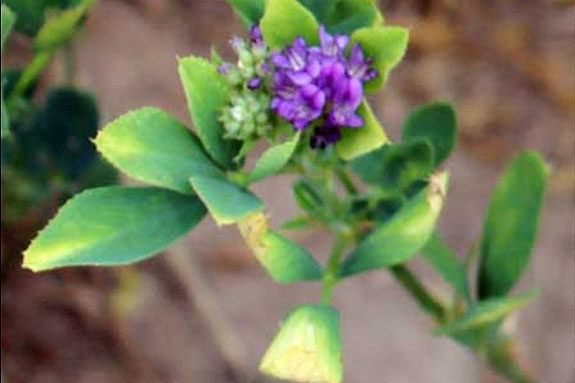The disruption and blockage of the vascular system is what leads to the first visible sign of potato leafhopper damage, the yellowing of leaf tips, often referred to as hopper burn.
The end result is a reduction in tonnage and quality. In severe cases of potato leafhopper feeding, whole plants and whole fields will turn yellow and be severely stunted.
Each year, potato leafhoppers blow in from southern states on storm fronts and are deposited in Michigan. Populations are variable from year-to-year, depending on timing of arrival and number, and how rapidly they reproduce once they arrive.
In typical moist, humid Michigan summers, potato leafhoppers are controlled naturally by a fungal pathogen that infects and kills the insect. The potato leafhopper population often crashes by the middle of August due in large part to the fungal pathogen.
Unfortunately, the hot, dry weather we have experienced this season favors potato leafhoppers.

The high temperatures allow leafhoppers to multiply quickly. The plant sap of drought-stressed plants is often more concentrated and nutritious for the insect.
Meanwhile, biocontrol is less, as the fungal pathogen is not active under low humidity. All of this results in potentially large potato leafhopper populations in fields.
At the same time, stressed plants are less able to compensate for sap removal and the effect of the toxin, so the impact of potato leafhopper feeding is magnified.
Potato leafhoppers are small and highly mobile and they are sometimes difficult to see and count. Threshold levels are not detectable by driving by the field or from the seat of a tractor or ATV.
Alfalfa fields that are at threshold may show few signs of damage. In alfalfa, a sweep net is recommended to sample potato leafhoppers.
Alfalfa thresholds are based on a combination of the number of potato leafhoppers per 100 sweeps and the height of the alfalfa.
• Below 3 inches = 20 adult potato leafhoppers per 100 sweeps
• 3 to 8 inches = 50 adult potato leafhoppers per 100 sweeps
• 8 to 12 inches = 100 potato leafhopper adults or nymphs per 100 sweeps or one per sweep
• Over 12 inches = 200 potato leafhopper adults or nymphs per 100 sweeps or two per sweep
Tall alfalfa that is over threshold can also be managed by timely cutting. Cutting is preferred because it may eliminate the need for insecticide use and avoids issues with preharvest intervals.
Be aware that neighboring fields of alfalfa and other crops will likely increase in potato leafhopper numbers as adults leave the cut field. Regrowth should be scouted and closely monitored after cutting, as the threshold is lower for shorter alfalfa.
If treatment of regrowth is necessary, insecticides applied to the shorter stand will have better coverage. Potato leafhoppers are relatively easy to control with insecticides and there are many registered products, including inexpensive choices. Note labeled preharvest intervals and warnings for applications if honeybees are nearby.
While drought is the dominate factor limiting alfalfa regrowth in several parts of the state this summer – southwest Michigan in particular – there is still moisture available for alfalfa regrowth in many areas.
Controlling potato leafhoppers will help alfalfa make the most of the limited moisture that is available and maximize alfalfa yield and quality in the face of a short hay supply. FG
—From Michigan State University Extension
PHOTOS
TOP: Typical “hopper burn” symptoms on alfalfa where leaf tips are yellow, progressing toward the base of the leaf in a V-shape pattern. Photo by Fred Springborn, MSUE
BOTTOM: A severely stunted and yellow alfalfa field impacted by both very high potato leafhopper numbers and drought. Cutting of the alfalfa followed by scouting of regrowth is recommended in such cases. Photo by Fred Springborn, MSUE










